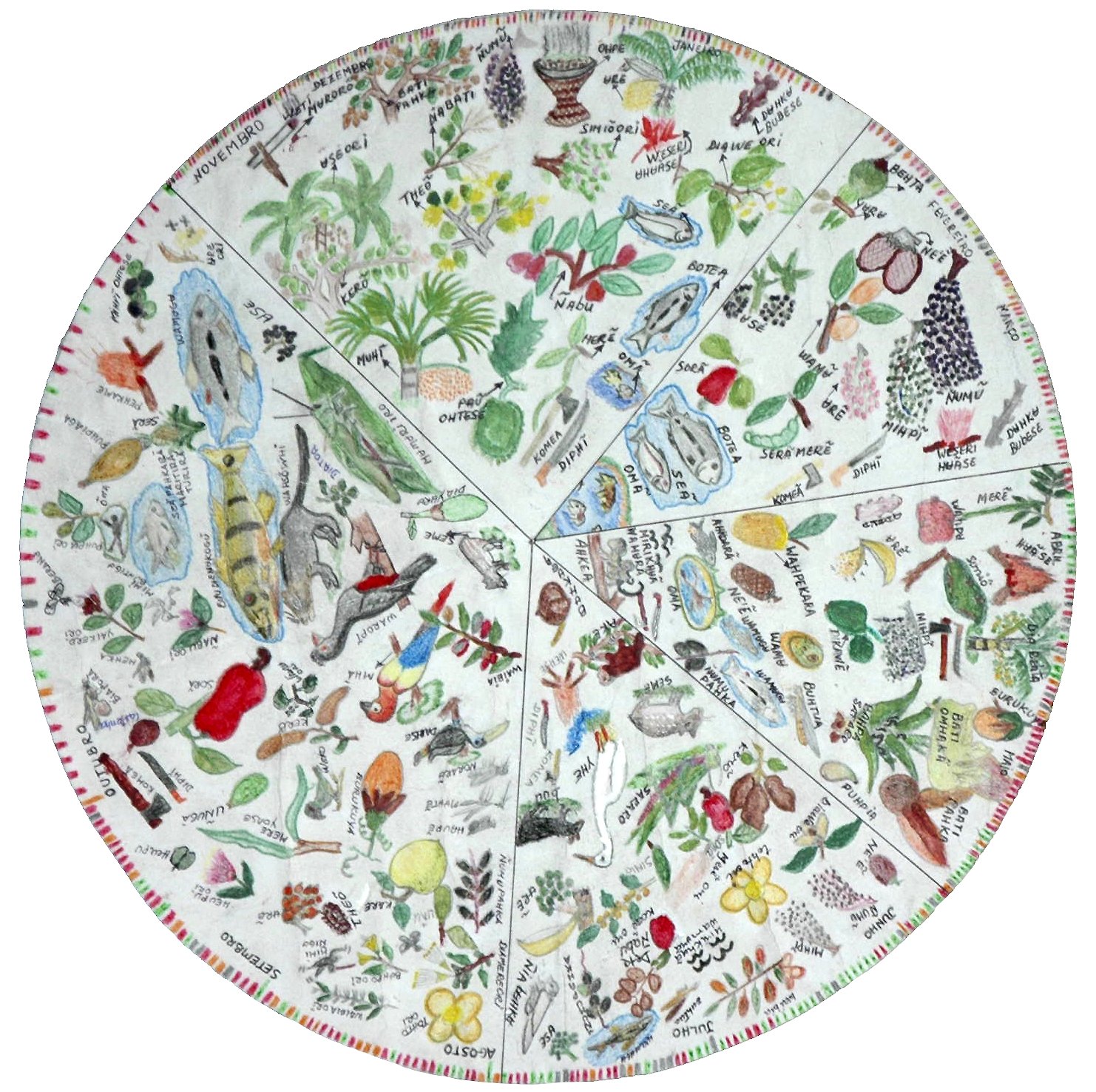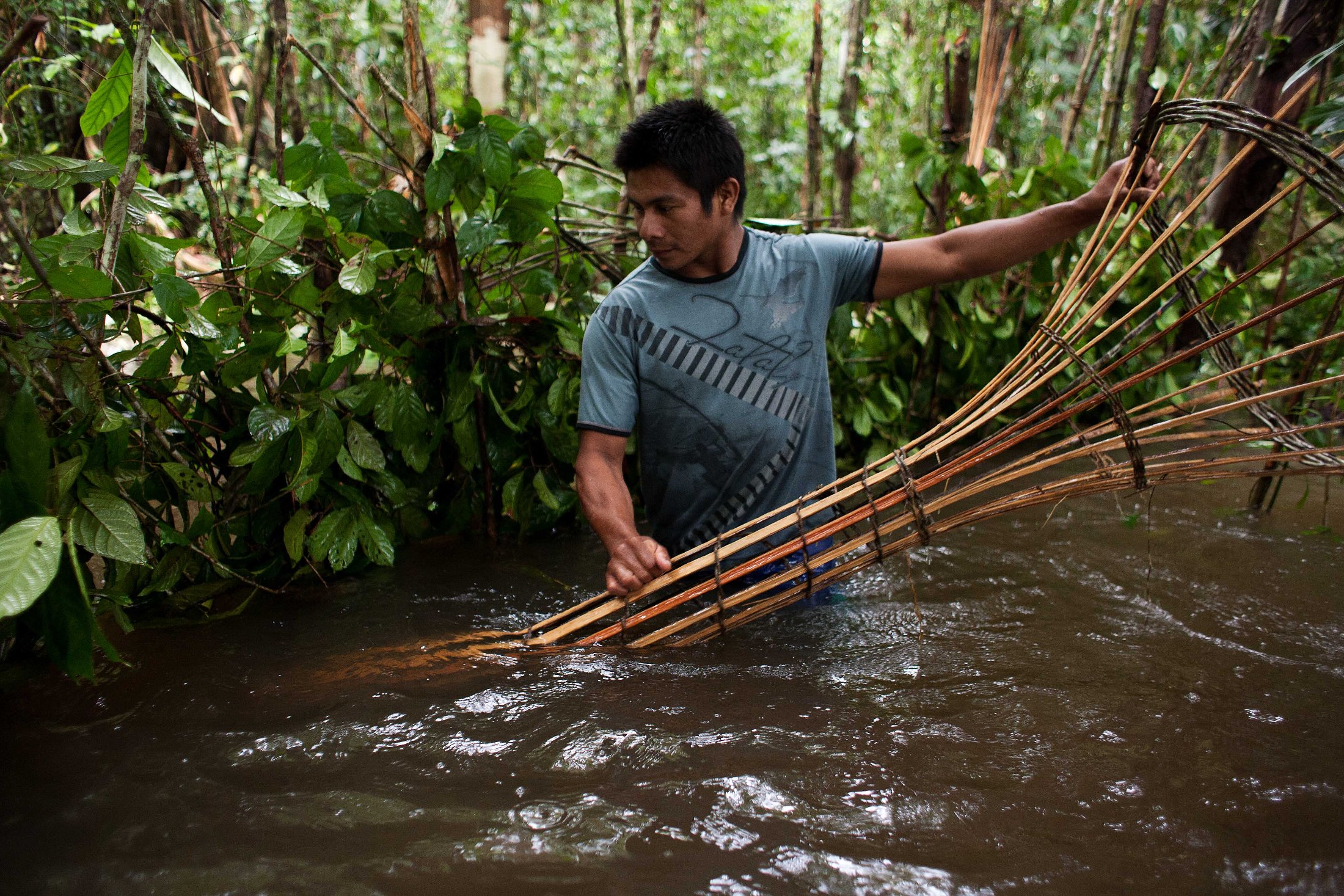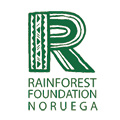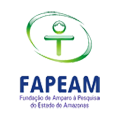Location of the communities on the Tiquié river
Indigenous peoples of the Amazon and climate change
Currently 21% of the Amazon region is occupied by and recognized as being for the exclusive use of indigenous peoples. In the Brazilian Amazon this proportion is 22%, while in Colombia it exceeds 50%. link com RAISG. Ethnological and archaeological research has demonstrated how indigenous knowledge and practices are largely responsible for the establishment and maintenance of the enormous environmental diversity of the Amazon. Whole landscapes are the result of specific management practices and the wide-scale distribution of species important for the regional economy is the result of the activities of indigenous populations. Recent research points to the importance of tropical moist forests, especially the Amazon rainforest, for the maintenance of ecosystem equilibrium at regional and global scales. The importance of the Amazon forest for the hydrological cycle that influences rainfall in central and southern Brazil is clear. Equally clear is the importance of avoiding deforestation in this region as part of a strategy to mitigate emissions of greenhouse gases, given that 15-20% of total emissions result from the conversion of tropical forests.
However, threats to this biome and its traditional populations are growing. National political and economic conditions have increasingly favored predatory pressures associated with agribusiness and large infrastructure projects for energy production and mining. Such development policies are gaining ground at the expense of indigenous rights and territories and of environmental legislation and governance. The current situation is one of tension and conflict over the environmental governance of large areas of the Amazon (link Amazônia sob Pressão).
Research on annual cycles, together with studies on climate, ecology, agronomy and other topics is, through observation and interpretation carried out within indigenous communities, generating detailed information regarding the annual cycles, thereby enabling an understanding of possible climate change in the region and the emergence of agreements and proposals for relevant public policies. Another result is the development and practical application of methodologies for environmental monitoring and analysis that could be extended to other regions of the Rio Negro and the Amazon. Such research would enable researchers and indigenous leaders to discuss on an equal footing the issues of climate change, its impacts on their territories and environmental management and governance policies for the Amazon.
Upper Rio Negro - Northwest Amazon
The northwest Amazon comprises the Upper Rio Negro, a border region between Brazil, Colombia and Venezuela and home to 31 peoples from four language families making up a multi-ethnic system that has existed since pre-colonial times. One the Brazilian side alone there are nine legally registered indigenous lands approved since 1997 and totaling over two hundred thousand square kilometers of continuous area. With a total population of 64,000 (2014 official estimate), distributed among 700 communities and small riverside towns, it is the region with the highest proportion of indigenous population in Brazil, over 80%.
The entire Rio Negro basin was more densely populated before Portuguese colonization. From the eighteenth century on its population was increasingly concentrated into villages, compulsorily relocated to undertake forced labor in the lower Amazon, and decimated in wars and invasions. The entire lower and middle reaches of the Negro and its tributaries were emptied of their original population. The Upper Rio Negro became a place of refuge that, although similarly the target of incursions and violence in the search for labor and forest products, was relatively less affected by these. The post-colonial geopolitical settlement, with the establishment of national borders, brought new forms of interference with the traditional social system, leading to present day consequences, such as militarization, education aimed at integrating these peoples into their national societies, dissemination of national languages (Portuguese and Spanish), dependence on industrialized goods, amongst others.
The town of São Gabriel da Cachoeira with a population of about 20,000 inhabitants is now the main regional urban center. Currently about half the population of the municipality is urbanized. This level of increasing urban concentration is problematic given that more than 90% of the area of the municipality is made up of indigenous lands. The city has witnessed a substantial population increase in the last thirty years due to migration of indigenous communities from the interior of the municipality and, to a lesser extent, the arrival of people from outside the region. The main incentive was the beginning of the construction of two roads, a stretch of the Northern Perimeter Highway and the BR307 highway, projects that were part of the National Integration Plan carried out by the military governments in the 1970s. A second cause was the establishment of military garrisons in the same period and the consequent increase in commerce and other services. Currently, the main driver of this migration is the federal conditional cash transfer program, whose implementation makes no concessions to the realities of life for indigenous families and takes no account of the long distances and lack of access to the banking network and commercial and other services in the interior of the municipality and indigenous lands.
In 1997, after years of claims by the indigenous population, the federal government approved the demarcation of five continuous indigenous lands in the upper and middle Rio Negro, comprising an area of over 106,000 km2, thereby creating the largest continuous stretch of demarcated indigenous lands of the country. The largest of these is the Upper Rio Negro Indigenous Land, covering the basins of the Uaupés and Içana rivers where most of the population is concentrated. Two further indigenous lands (Balaio and Cué-Cué-Marabitanas) were decreed In 2009 and 2013, totaling more than 10,700 km2. These lands are contiguous with the Yanomami Indigenous Land in Brazil and indigenous lands in Colombia and Venezuela.
The Tiquié river is about 380 kilometers long, 321 kilometers of which in Brazil, not including its multiple tributaries (one of which, the Ira, is almost the same length), and has its source in Colombia. It drains an area of 5,740 km², all of which is covered by primary and secondary forests, except for small scale clearings opened for human settlements and their forest gardens.
This river is inhabited by round four thousand members of eight different peoples belonging to two linguistic families: the Hupda and Yuhupda (Maku peoples) living in the interfluves and tributaries on both banks of the river and who make up a third of the total population; and the Tukano, Desana, Tuyuka, Miriti-tapuya, Bara and Yebamasa (Eastern Tukanoan peoples), mainly located along the main channel of the river. The Tukano language is the lingua franca throughout the Uaupés basin in Brazil, including the Tiquié; the others are also spoken, with the exception of Miriti-tapuya.
On the basis of its social and ecological characteristics the Tiquié can be divided into its lower, middle and upper reaches. The lower and upper Tiquié differ markedly from an environmental point of view, resulting in differentiated forms of environmental management. The middle Tiquié is a transitional zone between these two areas.
| Lower | Middle | Upper | |
|---|---|---|---|
| River | river with many meanders, lakes and low-lying flood-prone margins (extensive igapós [seasonally flooded forest]) | Igapós less extensive than on the lower river, presence of lakes and sections where the river bed is more channeled (higher ground) | river bed channeled (lakes and igapós are small and few), presence of rapids and waterfalls |
| Fish | abundance of fish, greater species diversity | average presence, diversity comparable to lower river | lower presence of fish and species diversity |
| Landscapes | predominance of Amazonian caatingas (acidic and nutrient-poor soils) and igapós | terras firmes (non-floodable intefluves), igapós and caatingas | greater availability of terra firme (higher and more suitable for agriculture) |
| Agriculture | less productive agriculture | agriculture more developed | agriculture more developed |
The Annual Cycles
The calendar of the indigenous peoples of the Rio Tiquié
For the indigenous peoples of the northwest Amazon, their knowledge and natural resource management practices are interwoven with the annual cycle. When they describe the annual cycle, the principal reference used by indigenous elders of the Tiquié river are the astronomical constellations (ñokoa wametise, in Tukano), the majority of which are located along the celestial equator. Each constellation has its narrative of origin, associated with a particular episode of the creation of the world. The constellation in question at any given time is the one that is setting in the early evening and visible at dusk. These constellations denominate a group of ten to twelve rainy seasons that follow in succession throughout the year. In Tukano these rainy periods are called poero; ‘winter’ days and rising rivers. These are interspersed with periods marked by sunny days and falling river levels, called in Tukano kuma ('summers ').
The indigenous annual calendar emphasizes certain phenomena and particular biological cycles as references - in particular, the hydrological cycle (precipitation and, above all fluctuations in river levels); the life cycles of fish, especially some species of aracu (genus Leporinus); and the agricultural calendar.
 The Flood of the Pit Viper (Aña poero) marks the beginning of the annual cycle in November and December. The first reproduction of fish, amphibians and insects occurs, related to the heavy rains and the rise in the river level. These first piracemas (spawnings) of the aracu-riscado, the aracu-três-pintas (and other species of Leporinusand numerous other species are considered to be the cleaning of the spawning grounds (ñeekoese), the longhouses where the fish hold their festivities, according to indigenous elders. During this period, only some of the fish are mature enough to spawn. Flocks of birds called “pit vipers” appear, land on the grass and then fall into the river and turn into fish. Despite this transformation they are not yet fully fish, which is why they are sometimes found to have the heart of a bird. They complete their transformation into fish upon spawning. At this time of year fishing is difficult and unproductive. The elders say that the "fish enter the anus of the pit viper", as if this were a building, a longhouse where they take shelter. Many pit vipers also appear. After the storms, the elders offer up prayers for protection. At this time of year pit viper bites cannot be cured, as they are transformed by thunder and lightning into celestial beings. Cures are only possible in the case of earth-born beings. The constellation of the Pit Viper is the largest in the astronomy of the Tukanoan peoples. It is divided into parts, the principal parts being: lumen (aña siõkha), head (aña dupoá), eggs (aña diepá), and tail (aña pihkorõ). These parts may give their names to short periods of rising waters (repiquetes), separated by a few days without rain (kumataro). Between the repiquetes of the parts of the constellation of the Jararaca the Summer of the Ingá (Mere kuma ) may occur, when the sun is strong and the winds light. (Ingá is a genus of small tropical, tough-leaved, nitrogen-fixing trees and shrubs, subfamily Mimosoideae.) Plots that have been cleared in secondary forest (as well as in primary forest, though this more difficult) can be burned to create forest gardens.
The Flood of the Pit Viper (Aña poero) marks the beginning of the annual cycle in November and December. The first reproduction of fish, amphibians and insects occurs, related to the heavy rains and the rise in the river level. These first piracemas (spawnings) of the aracu-riscado, the aracu-três-pintas (and other species of Leporinusand numerous other species are considered to be the cleaning of the spawning grounds (ñeekoese), the longhouses where the fish hold their festivities, according to indigenous elders. During this period, only some of the fish are mature enough to spawn. Flocks of birds called “pit vipers” appear, land on the grass and then fall into the river and turn into fish. Despite this transformation they are not yet fully fish, which is why they are sometimes found to have the heart of a bird. They complete their transformation into fish upon spawning. At this time of year fishing is difficult and unproductive. The elders say that the "fish enter the anus of the pit viper", as if this were a building, a longhouse where they take shelter. Many pit vipers also appear. After the storms, the elders offer up prayers for protection. At this time of year pit viper bites cannot be cured, as they are transformed by thunder and lightning into celestial beings. Cures are only possible in the case of earth-born beings. The constellation of the Pit Viper is the largest in the astronomy of the Tukanoan peoples. It is divided into parts, the principal parts being: lumen (aña siõkha), head (aña dupoá), eggs (aña diepá), and tail (aña pihkorõ). These parts may give their names to short periods of rising waters (repiquetes), separated by a few days without rain (kumataro). Between the repiquetes of the parts of the constellation of the Jararaca the Summer of the Ingá (Mere kuma ) may occur, when the sun is strong and the winds light. (Ingá is a genus of small tropical, tough-leaved, nitrogen-fixing trees and shrubs, subfamily Mimosoideae.) Plots that have been cleared in secondary forest (as well as in primary forest, though this more difficult) can be burned to create forest gardens.
There then follows the constellation and Flood of the Armadillo (Pamo poero) in January, a continuation of the period of fish spawning (piracemas) and of insect swarms. The Flood of the Armadillo is also characterized by collapsing river banks. Trees fall into the river and the water becomes dirty, muddy and frothy. It is the second constellation of the annual cycle and is divided into two parts: the piece of armadillo bone (pamõ oãduka) and the body of the armadillo (pamo ohpu). Then in February, the Summer of the Peach Palm (Ure kuma) occurs. Usually this is the longest of the year with a long drought that considerably lowers river levels, hindering or preventing navigation. It is an important moment in the agricultural calendar, since it is the main occasion for burning cleared areas of primary forest.
The short constellation and Flood of the Jacundá (Muha poero); jacundá is a generic name for fish of the genus Crenicichla, the pike cichlids) closes the period of strong ‘summers’. During this period of rising waters fish spawn and animals give birth. Then follows the Summer of the Umari (Wamu kuma; umari is the fruit of the Poraqueiba sericeia Tul., a tree species of the Icacinaceae family), lasting from a few days up to one week, with low water levels, which is followed by the Flood of the Shrimp (Dahsiu poero). In the narrative of origin, the Jacundá will swallow the Shrimp when this sets on the horizon. This flood happens in the unstable month of March and varies in duration from year to year. In April there may be some short “summers”, such as the Summer of the Abiu (Kar† kuma; abiu is the fruit tree Pouteria caimito), prior to the Flood of the Jaguar (Yai poero) in April. This is the first major high water period of the annual cycle, flooding all the igapós, leaving only the higher lands un-inundated, where animals - agoutis and acutivaias (rodents of the Dasyproctidae family), pacas (rodents of the genus Cuniculus), armadillos and other animals - can survive. It is a large stable flood where the waters neither rise nor fall much for a week or more. During the Body of the Jaguar phase all fish are able to spawn. There then follows a short dry period and the Tail of the Jaguar rains. This is the time to organize dabucuri (an offering ceremony) of bacaba (fruit of the Oenocarpusbacaba palm) and acai-do-igapó (fruit of the Euterpe spp. palm). The Flood of the Jaguar is divided into: the beard of the jaguar (yai ehseka poari), the head of the jaguar (yai duhpoa), the body of the jaguar (yai ohpu), and the tail of the jaguar (yai pihkorõ).
The period between April and July sees the greatest floods of the year. The first is the Flood of the Pleiades (Ñokoatero poero), when the last spawning of the year occurs. After this the first fish shoals - of aracu-riscado, aracu-três-pintas and others - begin the downstream migrations. This is a time of thunder and lightning. Sometimes it rains heavily, other times less so. The river rises a lot. During the rains of this constellation the tamiria birds appear. The Flood of the Fish Smoking Platform ( Wai kahsa poero) follows, during which the days of Aru occur, cold weather with frequent drizzle for almost a week and high winds, lightning and thunderstorms. Lastly there is the Flood of the Adze Shaft (Sioyahpu poero) with the start of the upstream migrations of schools of all the fish species: aracu-riscado, aracu-três-pintas, piaba, pirandira and others.
Up to this point, throughout the first nine months of the annual cycle, the seasons are well defined and clearly identified. From now (August) until the end of the annual cycle (October), the seasons are less marked and there is a greater level of variability among the indigenous elders as to how they are identified. In very general terms, the Constellation of the Heron (Yhe poero) and the series of Summers of the Iña (sometimes referred to as Iã or Hiña, seasonally edible caterpillars of the Cunuri trees, Cunuria spruceana Baill.) predominate.
In addition to the Constellation of the Heron, others occurring at this time and which are most frequently mentioned are those of the Otter (Diayoa), Bodó (Yahka; bodó is a name for several species of armoured catfish), Bihpia (a kind of bird), Ñamia (an ant species), Leaves (Puri), Thoto (a fruit), Sihpia, Tortoise (Uú), Kaisariro. River levels are very variable. There are years when the river remains in full flood until August or beyond, while in other years there may be long dry periods with low water in the river. There is a second phase of upstream migration of fish, now referred to as iña wai (fish-caterpillars of the cunurizeiro tree). The aracus are producing eggs. During the dry weather spear fishing takes place at night - tucunaré (Cichla ocellaris), acarás and jacundás (both cichlids) and other species - and with the river level so low it is possible to fish using timbó (a fish stupefying plant) in some places.
Fructification of the buriti palm, ingá, abiu, cucura (Pourouma cecropiifolia), peach palm, and japurá occurs, and begins in the cases of pahtid¡hka, umari and tohto. The preparation of new forest gardens continues; secondary growth is burned during the Iñadry period and, if it is really dry, of primary forest plots as well; planting follows. And so the annual cycle is completed.
Collaborative research
This is research about time, as this is understood on the Tiquié river. The object of the research, at this stage, is to understand these annual cycles and how and why they vary.
This long-term collaborative, intercultural and interdisciplinary research on annual cycles and their management is being carried out by indigenous communities and associations on the Tiquié in collaboration with the Instituto Socioambiental (ISA). It aims to describe, analyze and share information on the annual cycles and their variations, combining indigenous knowledge with scientific methods of recording and organizing data.
Origins
In 2005 a series of meetings and workshops on environmental management of the Tiquié basin were held with community associations, involving significant participation of community leaders and residents, including from the Colombian side, with the support and advice of ISA (which has had a permanent team of advisors and researchers in this river basin since 1998). Inter-community agreements on environmental management were discussed, with the view to strengthening indigenous governance of their territories. In these workshops, the multiplicity of factors associated with the dynamics of the life cycles and the history of environmental relationships, both biological and socio-cosmological, became evident. One of the action strategies identified was to establish a team of community researchers and workers, chosen by their communities, to promote activities related to environmental management. These were called Indigenous Environmental Management Agents (AIMAs).
An AIMA constitutes a type of community worker, facilitating good management practices (waste disposal, mapping the use of community areas and understandings and agreements on fish management, hunting, wild fruits etc.), information and research. AIMAs are residents of the community in question, can belong to differing age groups and have different levels of educational attainment (primary or secondary). They take part in a training program and knowledge exchange by means of workshops coordinated by ISA. The number of AIMAs on the Tiquié river is between twenty and thirty. There are research support bases in four communities, each with solar energy, computers, and meeting and lodging facilities. The AIMAs, like other community residents, are involved in the daily work of the community, but dedicate a part of their time to research activities. They receive a stipend proportional to their commitment of time and their qualifications, together with some work instruments and fuel needed for necessary journeys. In the words of Roberval Pedrosa, a Tukano of the Sierra de Mucura community and an AIMA since 2005, "we are researchers into the management of the world."
Methodology
The essential tool for research into annual cycles is the daily diary entry, whereby each AIMA records a set of observations on: (1) rainfall; (2) river levels, measurements of rising and falling waters, and navigation conditions; (3) the name of the season in the indigenous language; (4) the phenology of important plants - fruits (cultivated and wild) and flowers; which are ripe and are being consumed, by people, fish and animals?; (5) Fish (and animal) cycles: migration, spawning and reproductive gatherings, the food they eat, and fishery management practices; (6) reproduction, behavior and migration of mammals and birds; (7) reproduction of insects and amphibians (e.g. ant swarms, frogs spawning, appearance of edible caterpillars). linkar págs 46-55 do Manejo do Mundo, versão on line
The daily life of the community and the activities of its residents are also recorded, such as communal meals, news about hunting and fishing, agricultural activities (clearing of primary or secondary forest, burning, planting, harvesting), festivities and community rituals. Details of the most common illnesses are also recorded.
The diaries are not standardized. The AIMAs are given exercise books, pens and drawing materials and a list of suggestions (above) for observation and recording, as well as the advice to write daily; but each has complete freedom to do so or not and in whatever way they are able.
The concern to collectively systematize the information recorded in the diaries led to the organization of workshops, held since 2006, usually involving the AIMAs of one of the regions of Tiquié together with ISA researchers. For these small workshops, lasting about a week, a methodology has been adopted that emphasizes the visual presentation of data. The diaries are read and a timeline is plotted for each of the regions, as there are significant variations between these. For example, there are phenomena that occur in the lower and middle Tiquié, but not in the upper, such as the migration of certain species of fish that do not go further than the first falls of the river. Different types of circular representations of annual cycles are also drawn. The elder knowledge holders are also invited to these workshops and relevant issues are examined from different points of view, thereby generating much information of interest for management and research.
Manejo do mundo
Manejo do mundo (“management of the world”) is a way of translating the idea of those practices that involve observing, understanding, healing, protecting, mediating, repairing, communicating, sharing. It is management that, as carried out by each people and community, is undertaken at multiple scales - from the household to the territory.
In the words of the Tuyuka elder Domingos Valle of Bellavista, Abiu creek, upper Tiquié in Colombia (who died 2013), "the elder knowledge holders of the ecological calendar perform protective prayers at the appropriate time for carrying out particular activities and for protection against certain diseases prevalent at that point in the cycle. At the specific ceremony for each time in the cycle, if the prayers are not properly done - correctly specifying what may befall the person at the particular time for each step of the activity - the person can fall ill with disturbances to their soul or heart. We elders count the passage of time by the constellations, but nowadays we know the names of the months as well”.linkar páginas 20-23 do Manejo do Mundo

Ignacio Valencia, an important Makuna elder from the Machado creek, touches on points that are fundamental to an understanding of the notion of manejo do mundo:
"Just like space and time, which provide everything without anyone telling them to, we kumua (shamans) are merely the ones who regulate these so that everything functions properly, without illness, war or hunger, in order to survive in a world where no one can alter the rotation or direction of Our Earth - Makarikiro - or change its behavior. Therefore we say that we walk the path indicated by our creators the Ayawa, with the same elements and rules they have left to us and that we eat according to what they have shown. For this reason we feel very content with our territory, sharing, living and using what our Creators indicated that we should use.
More than anyone, more than humans, it is the animals who know best how time works. Humans on the other hand pay attention only to what happens in the visible world. As we see all this happening, we kumua undertake Cure and Prevention to become spiritually aligned with the animals, as we humans are also part of the animal world, because we feed on certain species of wild fruit trees like them. For this we must first prevent disease, and second we make cures so that the fruits do not bring illness when they are consumed by humans. This is the reason for the rituals that take place during this period, particularly to prevent illness and to cure species for human consumption, whether they be fruit, animals or fish.
This is how the Ecological Calendar works and no-one can alter or destroy what has been the same since the beginning. This is how it is and this is how it happens because from the beginning of time the same animals have been the protagonists of the stories of the origins, together with the Ayawa, in the different events. Therefore, they know very well when production of fruit occurs and when it does not, when is the time to raise children and when not. They're smarter than us, there’s a reason why they live in the forest.
This way we know that we indigenous people are connected to the animal and plant world, which occupies the same space we live in. This is the method we have to manage our own territory. Knowing and practicing our Ancestral Knowledge (Kumua Baseri Keti Oka), for now we can say, that while we kumua are alive, management will remain in effect. In order that this knowledge can be assured of remaining in force, we are building and strengthening this management through this research, which is extremely important for future generations."









